History of the Sikora
Family
Milwaukee, Wisconsin
Compiled by Brendon Baillod
Introduction
This short document has been
prepared by Brendon Baillod in 2008 to record the pertinent historical data
about the Sikora family that emigrated from Poznan, Poland
to Milwaukee, Wisconsin
about 1886.
I’ve included as complete as
possible a picture of all descendents of this family. This history consequently, includes many
families that most of us have never met or heard of. Over the years of preparing the genealogy, I
was surprised at the number of descendents this family has produced. In fact, on more than one occasion when I
lived in Milwaukee, I discovered
through research that I was related to persons that I had already met through
work or social functions, without realizing that they were a cousin. The descendents of Sikora
families now number in the hundreds and I’ve captured information on many of
them in this history, especially if they were born before 1930. However, I am missing much data for persons
born after 1950. It is also important to
note that several other Sikora families settled in Milwaukee
and are NOT closely related to us. The
names are fairly common in Poland
and one can find other Milwaukee Sikora families on
the US Census that are from other parts of Poland.
The information in this history
was compiled over a period of 20 years from many different sources, including
interviews, newspaper obituaries, US Census data, Church records from many
Milwaukee parishes, Civil records from the Milwaukee County Courthouse,
Naturalization documents from Federal Court, old City Directories, Cemetery
records, ship passenger lists, the Social Security Death Index, and many
different online genealogical databases.
I have copies of most of the original documents such as marriage
licenses, death certificates, birth records, obituaries, etc., that were
referenced and would be happy to make copies for anyone who wishes to see
them.
This information has also been
entered into a genealogical database which I placed on the internet several
years ago at Ancestry.com and Rootsweb.com.
Names and dates for living persons
do not appear in the online version of the database. I would be happy to share electronic
copies of the database with any family members who request them. I would also appreciate updates from family
members regarding births, deaths and corrections to any errors. In addition to the above data, several years
ago I also placed short narrative history of the Sikora
family online at baillod.com. I was
subsequently contacted by many family members and distant cousins who found the
site and provided information for this family history. It is
my hope that this history supplies interesting information for your family and
provides an important sense of identity in our increasingly generic American
culture.
Brendon Baillod – Madison,
Wisconsin – May 2008
brendon@baillod.com
www.baillod.com
Poland
The surname Sikora
is derived from a Polish word for the Titmouse bird. This name does not have any noble
connotations but is very common in Poland
to this day.
The Sikora
families of interest to this discussion originate in the province
of Poznan,
Poland. The families identified “Posen” as their
place of origin on the US Census and on other civil records. The families most likely were referring to
the Province of Posen,
rather than the City. Posen is the
German name for Poznan,
which is the historic cradle of the Polish state and is one of the richest and
most developed areas of the country. It
was an early center of learning, religion, international trade and culture,
beginning around 900 AD. Poznan was a very cosmopolitan
area and many different ethnic groups settled there, including many Jews. However, beginning in the late 1700s, Poland
was partitioned and taken over by powerful neighboring countries. Poznan
became part of Prussia
and was subjected to German colonization. In 1871, Germany
gained formal control of Prussia
and began a program of forced Germanization of the
Poles. Many Poles were displaced from
their homes by German colonists, and Poles were forced to adopt German names
and culture. Many Polish towns were
renamed and Polish landowners lost their holdings.
Church records in Poland
point to the feudal village of Zabartowo in the District of Wyrzysk in northern Poznan as the place of origin for our Sikora
family. People of the Zabartowo area were principally involved in sheep herding
and agriculture. Zabartowo
is a very old village dating back to the 1300s.
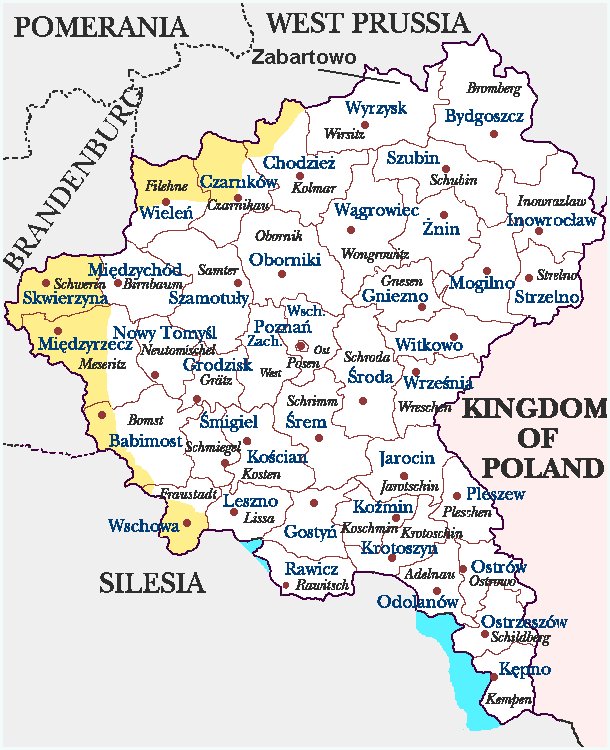
Province of Poznan c. 1870 showing Zabartowo
For most of Poznan’s
Poles, life was difficult long before the start of Germanization. Much of the population of Poznan were rural farm workers and laborers. Like most Poles, they were heavily Roman
Catholic and lived a nearly feudal existence in which they were legally bound
to the landowner on whose property they lived.
They engaged in meager subsistence agriculture and produced crops of
wheat and wool for their landowners who were often foreigners. It was a hard existence where disease and
famine regularly wiped out entire generations and ethnic and nationalistic
feelings often erupted into violence.
It was from this background that
most of America’s
Poles came in the period 1871 – 1900. Many
were leaving to avoid conscription into the German Army, while others wished to
retain their Polish culture. Others were
fleeing the feudal rural society in search of a better life. Many had run afoul of German officials. All had saved money for many years for the
opportunity to escape a difficult life with poor prospects for the future. Often, large families would pool their money
to send one member to America
in hopes that they would earn enough to bring the rest of the family over. Upon
arrival in the US,
the Poles were generally counted as Germans because Poland
had ceased to exist. For naturalization
purposes, the Poles had to renounce loyalty to the German Emperor because there
was no longer a Polish state. Many Poles
had also been forced or chose to take German last names. As such, the actual number of Polish
immigrants to the US
has generally been dramatically underestimated and in the case of Milwaukee’s
German immigrants, a substantial number were actually ethnic Poles.
Little is known about our Sikora family in Poland. They were almost certainly rural Polish
peasants, living in the small villages of the Wyrzysk
district of northern Poznan. However, we do know a few interesting facts
about our Sikora family in Poland. Michalina Sikora, the eldest daughter of Jozef
and Katarzyna Sikora is
shown on the Zabartowo marriage index at the online Poznan Marriage Index Project database. She married Frank Grzybowski
at Zabartowo in 1876.
It is consequently, believed that our Sikora
family originates in this area. To date,
the remaining civil records of Zabartowo have not
been transcribed, but several Sikora families can be
found in the area.
Immigration
Fortunately for Poznan’s
Poles, the German occupiers had no objection to their leaving. Poles consequently left Poznan in droves between 1871 and
1920. The main impediment to leaving was
money. Few Poles could earn enough money
to purchase a ticket to America
and Polish landowners were not eager to see their free labor force depart,
often erecting obstacles to leaving. The
cost for a steerage class ticket on a transatlantic steamer in 1890 was about
$20, which was a year’s wages for the average Polish peasant, but for most Poles,
the ticket included train passage to their destination as well. The principal ports of embarkation for Poles
were Hamburg, Antwerp
and Bremen, which were a few
hundred miles from Poznan
by train.
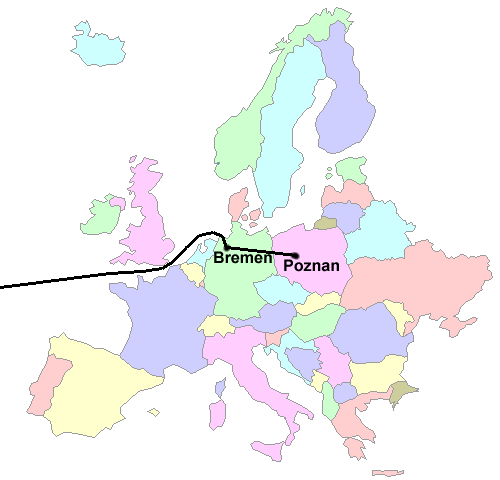
The Sikora Family Route from Europe
The immigrant ships of the 1880s
and 90s were not glamorous. They were large steamships, often with wooden hulls
and upper decks geared toward first class passengers, with the rest of the ship
reserved for steerage passengers.
Steerage passengers were generally housed below deck in common areas
with bunks and a common mess area. After
several days journey by train or carriage to the coast, the passengers boarded
and set up housekeeping for the two week passage from Europe
to the US. Almost all passengers were seasick within a
few hours of leaving port. The misery generally persisted for a few days until
they got their sea-legs. On board ship,
the passengers would compare notes on what they had heard about America
and exchanged advice on living in America. Sometimes, families from specific villages
would travel together. The ships
generally landed at New York, Baltimore
or Philadelphia. Baltimore
was a favorite among Polish passengers because of the city’s reputation for
providing aid to Catholic immigrants and the ready availability of work. Baltimore
was also popular because of an agreement between German steamship lines and the
Baltimore & Ohio Railroad that allowed passengers to purchase one ticket
for both the ship and train passage to their destination.

SS Illinois – A woodcut
engraving of the vessel the Sikora family took to
the US
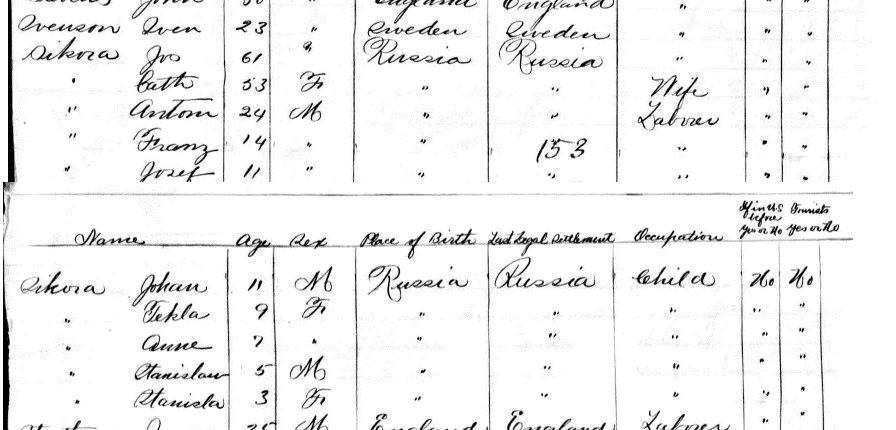
The
Sikora immigration manifest from the SS Illinois
The Sikoras
left Europe through the Port of Bremen, Germany in early
April of 1886 and after a brief stop at Liverpool,
England, they boarded the Red Star line steamer SS Illinois for the
trip across the Atlantic. They arrived in the US
through the port of Philadelphia
on April 26, 1886. The family included Jozef,
age 61, Katarzyna, age 53, Anton, age 25, Francisca,
age 14, Joseph, age 11, John, age 11, Tekla, age 9,
Anna, age 7, Stanislaus, age 5 and Stanislawa, age
3. The family appears on the manifest of
the Steamship Illinois in the Port of
Philadelphia Passenger Lists.
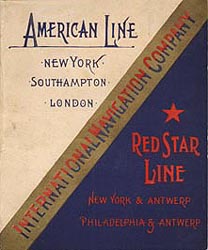
A Red Star Line
Brochure 1890
Despite the primitive and often
filthy conditions on the ships, all the Sikoras
survived and made it to America. Upon arriving in Philadelphia,
the Sikoras immediately went by train to Milwaukee
where they likely had friends or acquaintances.
Naturalization documents for the Sikora men
that immigrated are in the collection at the Milwaukee County Historical
Society confirming that they arrived at Philadelphia
in April of 1886. There is evidence that
the Sikoras knew other Milwaukee Polish families that
had already made the journey. Once in Milwaukee
the Sikoras became intermarried with the Czaplewski family, who were also from Prussia
and may have been from the same area of Poznan.
The Sikora
family had at least three adult children who did not emigrate with them. Daughter Michalina Sikora emigrated with her husband Frank Grzybowski
and children in 1887, daughter Josephine emigrated with her husband Teofil Labecki in 1880 and
Daughter Elizabeth Sikora emigrated in 1883,
apparently with her fiancé Joseph Szot. The two were married in Milwaukee
on July 23rd, 1883. The marriage certificate lists Elizabeth’s
parents as Jozef Sikora and
Katarzyna Szweda.
Milwaukee 1880 – 1930
The Sikora
Family
When the Sikoras arrived in Milwaukee in 1886,
they almost certainly knew people who had emigrated earlier. Poles had been coming to Milwaukee
for almost 30 years and a large Polish community was already in place on Milwaukee’s
south side. It was consequently, not
necessary to speak English in order to find work. By 1890, they had settled at 1011
Grove St. (now S. 5th
St). The Sikoras lived there with the Czaplewski
family which they would marry into several times. They attended St. Stanislaus Church on 5th
and Mitchell St as well as
St. Josaphat's on 6th and Lincoln
and St. Hyacinth's on 14th and Becher. Almost all of the men in the family worked in
the iron industry. They were teamsters
in the iron foundries as well as moulders and
ironworkers. The women also worked. Many of them worked as dressmakers and
knitters in the garment industry on the South Side. The National Knitting Company and Phoenix
Hosiery employed many of the Sikoras.
Jozef and Katarzyna Sikora were already middle aged when they emigrated to the US. Records vary as to the dates of birth of Jozef and Katarzyna. Jozef's tombstone
at St. Adalbert's places his birth in 1826, but his
death record at the Milwaukee County Courthouse gives his date of birth as June 15, 1837. His stated age on
other documents suggest that the 1826 date of birth is the correct one. Katarzyna's Death
Record places her birth at November
26, 1845, but US Census data and her age given on the immigrant
ship manifest indicate a date closer to 1837.
Unfortunately, Katarzyna's grave at St. Adalbert's has no marker to give an additional date. As I went through the archival records of
this era, I found that many dates and spellings were inaccurate. This seems to be partly due to the language
barrier that probably existed between the early Polish immigrants and the
recording officials, and partly due to errors on the part of those reporting
the data. It should also be noted that
there were as many as four separate Sikora families
which emigrated to the South Side of Milwaukee between 1880 and 1900. Only about half of the Sikoras
living in Milwaukee today trace
back to Jozef and Katarzyna.
The Catholic Church became an
extremely important social, cultural and religious center for Milwaukee’s
Poles. Early Polish Immigrants had
founded St. Stanislaus Church on 5th and Mitchell in 1866 and many
other Polish churches quickly followed, including St. Hyacinth and St. Josaphat’s where Stanislawa Sikora would marry.
The early Sikora family members belonged to
St. Stanislaus. Few of Milwaukee’s
Polish immigrants maintained ties to the old country, particularly during the
1880s and 1890s. Second generation
Milwaukee Poles often reported that the old country was seldom talked about and
was not remembered fondly. Milwaukee’s
early Poles also avoided discussing what part of Poland
they were from, possibly to shed the old nationalistic and ethnic pressures
from Poland. In any case, few of Milwaukee’s third
generation Poles knew much about their ancestors in Poland or where in Poland
their families had come from.
Generally, new immigrants stayed
with another family when they first arrived and worked until they could rent a
house. The 1900 US Census for Milwaukee
shows many houses with as many as 25 people living in them, constituting 3 or 4
different families. Around the turn of
the century, a Milwaukee Polish household often consisted of one or more
grandparents and the entire families of 2 or 3 married adult children. Most families had more than five children and
many had upwards of 12 children. After 5
or 10 years of working in Milwaukee,
most families could afford to buy a home in Milwaukee’s
Polish core and in about 1890, the Sikora family
moved to a house at 1011 Grove St. At this time, everyone over age 13 in the
household worked to support the family.
Still, the 1880s – 1910s were tough times for most Milwaukee Poles. Conditions were much better than those in Poland,
but the jobs they did were often menial and dangerous. Wages were low, work hours were long and Milwaukee’s
German officials often viewed them with disdain. Many Milwaukee Poles chose to identify
themselves as German and even to Germanize their names in order to be more
upwardly mobil in Milwaukee
society.
Jozef and Katarzyna’s
daughter Michalina married Frank Grzybowski
in Poland in
1876. They left Poland
and arrived in Milwaukee around the
same time as the rest of the Sikora family. At the time of their immigration, they had
two or three young children. Michalina and Frank had 8 children between 1876 ad 1898
including Antonine (1879), Casimir
(1883), Stanislawa (1886), Stephen (1889). Frank (1891), Roman (1893), John (1895) and Roman (1898). Michalina died November 10, 1936 and is buried at
St. Adalberts Cemetery.
The next of Jozef and Katarzyna’s
children to marry was Josephine. She
married Teofil Labecki
(sometimes seen as Labenski) in Poland
in about 1880. The couple emigrated to the US
shortly after marriage. They settled at 1805
Garden Street and had children Matt (1883),
Francisca (1885), Anne (1886), Rose (1888), Boleslaw
(1890), Stanislaus (1891), Bronislawa (1894), Frank
(1895) and Aloise (1897). Daughter Francisca married Casimir Kasprzak about 1905 and
had children Anton, Alice (Lenzen) and Hilda (Datka). Today, Hilda
Datka’s headstone at St.Adalbert’s
Cemetery marks the resting place of Hilda Kasprzak Datka, her mother Francisca Labecki
Kasprzak, Hilda’s grandmother, Josephine Sikora Labecki and Hilda’s great
grandmother, Katarzyna Szweda
Sikora.
The next of Jozef and Katarzyna’s
children to marry in the US
was Elisabeth Sikora.
She married Joseph Szot in July 1883 at Milwaukee
and had children Mary (1885), Frank (1890), Laura (1892), Edward (1893), Paulina (1897) and Joseph (1899). Joseph Szot died
before 1900, and the family moved in with Elisabeth’s sister Francisca. The family Germanized its last name to Schott
by 1900 and Elisabeth lived with her children and worked as a laundress until
her death on May 1, 1937.
The next of Jozef and Katarzyna's
children to marry was Francisca Sikora. She married Anton Borzych
on February 6, 1888 at St.
Stanislaus Church. (Milw. Cty.
Marriage Rec.) The Borzych
family would grow to include Peter (1888), Joseph (1890), Anton (1891), John
(1894) and Paul (1896). Although many of
the children died young, this family remains in the Milwaukee
area to the present day, and consequently, many Borzych's
are 2nd and 3rd Cousins. The Borzych family settled at 433
Smith St., very near the family of Francisca’s
sister, Tekla, and Anton worked as an Iron Molder. Francisca’s husband Anton died in 1904 from
alcoholism and she remarried Frank Kozak in
1909. Francisca died in 1912 and is
buried at St. Adalberts Cemetery.
The next of the children to marry was Tekla Sikora. She married
Albert Kordus on January 13, 1890 at St. Josaphat's
Church. Albert was born in Poznan, Poland
in 1866. The Korduses
settled at 1065 1st Ave. in
Milwaukee and Albert worked as an
Iron Moulder.
By 1891 they had their first child, Leon Kordus. Subsequent children were Martha in 1894,
Edward, 1895, Magdalene in 1897, Emil in 1898, Clemens in 1907, Harry in 1909,
Esther (who later married Frank Banach) in 1913 and
Henry Kordus in 1919.
Descendants of this family can also be found throughout the Milwaukee
area to this day.
In September of 1890, Anton Sikora married Katarzyna Wierzba at St.
Stanislaus' Church. They moved in with Katarzyna's family at 511 Maple St. Anton worked as a teamster in a washer
factory and soon bought the house from the Wierzba
family. It is interesting to note that
on the 1910 Census, 24 people were living in the house at 511
Maple St., comprising five different families. In
later years, Anton's mother came to live with the family and died at the
house. In 1893 Anton and Katarzyna had their first child, John Sikora. Next was Frank in 1894, Anton Jr. in 1896,
Stanislaus in 1897, Paul in 1899, Julia (Sikora) Kenitz in 1901, Martin in 1905, Harry Sikora
in 1907, Felicia in 1910 and Catharine (Sikora) Chmielewski (who married Frank Chmielewski),
in 1912. Most Sikoras
remaining in the Milwaukee area
descend from this family. The family of
Anton Sikora was close with the family of Michael Grochowski and Michael’s daughter Magdalena Grochowski lived with them in 1920.
On October 24th, 1892,
Joseph Sikora married Amielia
Grzybowski at St. Josaphat's
on 6th and Lincoln. They settled at 1018
Garden St. (now S. 5th
St.) and Joseph began to work as an Iron Moulder at Harvestor
Foundry. This family had 5
Children. In October of 1895 they had
Roman Sikora, in April of 1897, John Sikora, in January of 1899, Emil Sikora,
in 1901, Henry Sikora and in 1905 Josephine Sikora.
Anna Sikora married Joseph Czaplewski
on February 19, 1895 at St.
Josaphat's.
They settled at 1018 Garden St.
and Joseph began work as an Iron Moulder in the
Foundries on Milwaukee's South
Side. The Czaplewski's
had three children; John in 1896, Mary in 1898 and Helen in 1900. On September
12, 1907 Joseph died of alcoholism.
After this event, Anna and family moved in with her brother Joseph Sikora Jr. Anna
worked as a washwoman and later for the Street Railway Company.
On May 29, 1896, John
S. Sikora married Joseph Czaplewski's
sister Veronica Czaplewski at St. Josaphat’s. Veronica was born in May of 1877 in Poznan. John began work as an Iron Moulder and the family settled at 824
Garden St. and lived over the next 5 years at 1289
2nd Ave and 2623 S. 7th
St. They
had ten children; Joseph Sikora in 1897, Edward
W. in 1899, Ladislaus (Walter) J. in 1902, Johanna
in 1904 (deceased 1915), Irene (Sikora) Jablonski
in 1906, John Sikora Jr. on June 14, 1909, Raymond
Sikora on August 29, 1912, Margaret (Sikora)
Meyer in 1915, Veronica (Sikora) Potocky
in 1917 and her twin sister Esther at the same time. These families also have MANY children and grandchildren
living in the Milwaukee area at
present.
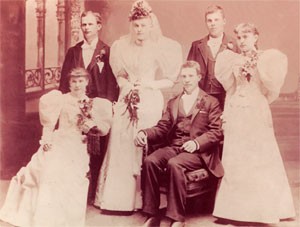
The marriage of John and Veronica Sikora
Stanislaus Sikora was the last of the men to
marry on September 9, 1903. He married Mary Kasprsyk
who was born in Poland
in 1880. Stanislaus and Mary settled at 980
10th Avenue in Milwaukee
and Stanislaus went to work as an Iron Moulder as
well. By 1940 the family lived at 2059
S. 16th St.
They had eight children. Irene
was born in 1905, Helen in 1907, Alois in 1908, Emily
in 1911, Martha T. in 1915, Edward in 1917, Ervin S. in 1919 and Ralph in 1920. Stanislaus died in 1955 and Mary died in
1962, both in Milwaukee.
The last to marry was Stanislawa or Stella Sikora. She married Michael Grochowski
on October 23rd 1900 at
St. Josaphat's. Michael's sister Francisca Grochowski had married Joseph and Veronica Czaplewski's brother John Czaplewski. Subsequently, Michael met Stanislawa
to whom he was already heavily in-lawed while he was
working as a foreman at the National Knitting Company. Michael and Stanislawa
had a number of children, including Helen Grochowski
(1901), Eva Regina Grochowski (1903), Magdalene Grochowski (1905), Sylvia Catherine Grochowski
(1907), Tadeus Stanley Grochowski
(1908), Josephina Grochowski (1911), Mary Grochowski (1912), Felecita Grochowski (1915), Delores Grochowski
(1921) and other children who died as infants.
(These individuals are buried at St. Adalbert's
Cemetery in Section 12, Block 7 in unmarked graves.) Michael and Stella first lived at 1013
Grove St. (now S. 5th
St.) in 1905 and Michael worked at the National
Knitting Company at 889 Clinton St.
(now South 1st St.). By 1910, Michael and Stella had moved to 1010
6th Ave. (now S. 11th
St.) where they rented. By 1920 the family had bought their home at 3055
South 15th St.
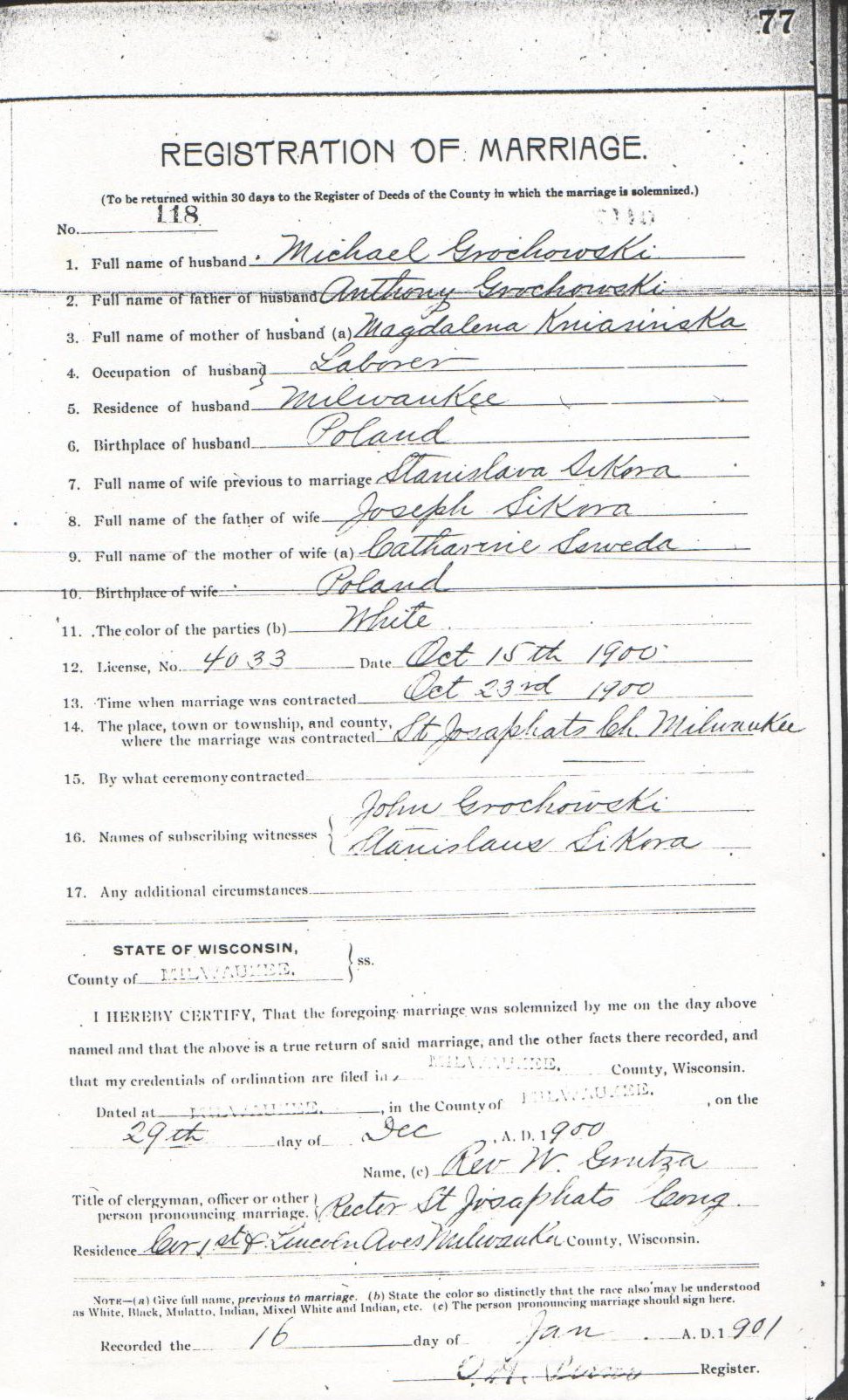 |
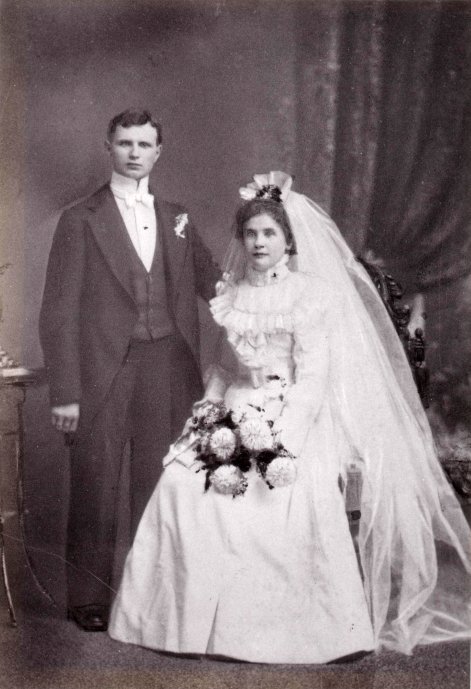 |
The marriage of Stanislawa
Sikora and Michal Grochowski
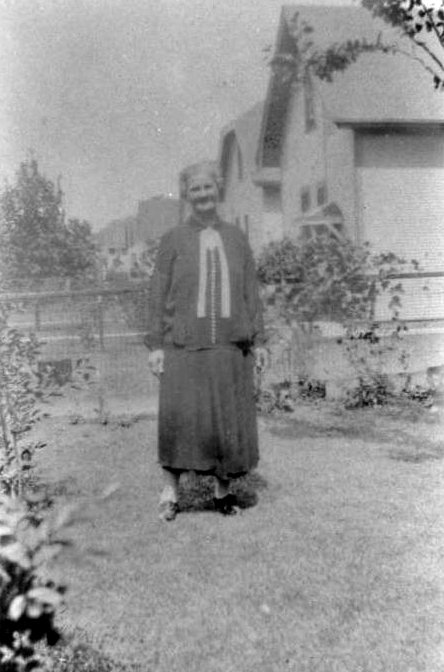
Stella Sikora Grochowski in her backyard about 1930
Jozef Sikora, the family
patriarch, worked as a glove maker in his later years and died at his home
on 1011 Grove St. on July 31, 1909 at the age of 83. He is buried at St. Adalbert’s
in Block: 12, Row: 6, Grave: 3. Katarzyna (Katherine)
Sikora died September 11, 1919 at the home of her son Anton at the age
of 83. She is buried at St Adalbert’s in Section: J, Block: 2, Lot: 16n2 next to her
daughter Josephine.
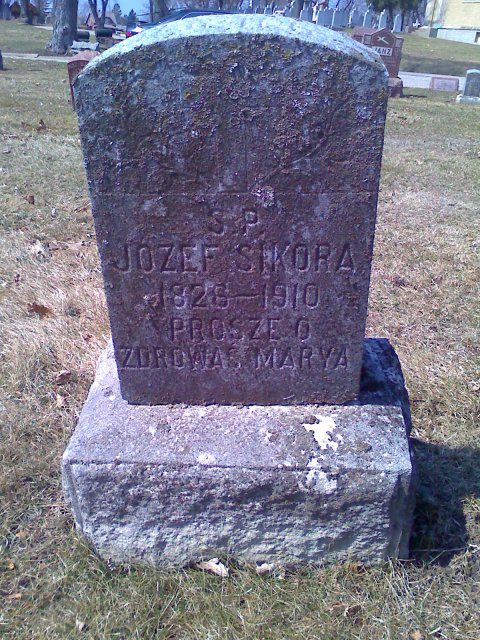
The headstone of Jozef Sikora (note the error in
year of death)
Milwaukee & Suburbs 1920 – 1970
The period 1920 – 1970 was an
important transitional one for Milwaukee’s
Polish immigrants. The first generation
of immigrants had passed away and the second generation were
aging. The most pronounced change during
this period was the migration of Milwaukee Poles out of the old neighborhoods
around Mitchell and Lincoln into newer neighborhoods to the south and west. During this time, Michael and Stella moved to
1159 1st Ave.
(now S. 6th St.),
and were living there in 1920, but by 1925, they had moved to 3013
S. 15th St.. A large contingent of the Sikora
families settled around 15th and Oklahoma
Ave., while others moved to Bay View, South
Milwaukee, the Town of Lake,
and later to Greenfield, Hales
Corners, Waukesha and other
suburbs.
The driving factors behind the
migration were education, prosperity and congestion. The old neighborhoods had older homes and a
high population concentration. As the
second and third generation became educated and literate, they tended to get
better jobs. Michael Grochowski,
who had started working in the hosiery shops in the 1890s had become a foreman
and could afford a new home of his own outside the old Polish core. Many other Sikora
descendents followed suit and few of them lived in the old neighborhoods by
1930.
After WWII, education played a
major factor in the upward mobility of Milwaukee’s
Poles. The Polish Catholic church had a
strong history of promoting education, and Milwaukee’s parochial schools sent
many fourth generation Poles to colleges and universities. Others participated
in Milwaukee’s postwar industrial
boom and did well for themselves as skilled laborers, often unionized. Many Grochowskis
and Sikoras worked as Machinists, Mechanics, Machine
Operators and other skilled industrial occupations during this period.
The Catholic Church continued to
be very important for Milwaukee Poles and remained an important center for
social, cultural and community events as well as education. The Sikoras of the
1930s – 70s were generally affiliated with the newer churches outside the
Polish core.
Michael Grochowski
died unexpectedly in 1931 from Pneumonia.
He probably continued to go to work when he should have been in
bed. Medical care was much more
primitive at that time, and Michael would likely not have died had the illness
occurred even ten years later. However,
the Great Depression was in full swing and there were likely many people
willing to take Michael’s job if he didn’t show up for work. Michael left a fairly young family, which had
to weather the Great Depression without a father. Stella worked as a seamstress after Michael’s
death and the children old enough to work did so, mostly at the National
Knitting Company and at Phoenix Hosiery.
Michael was buried at St. Adalbert’s near many
of his children that died young in Section 12, Block 7, Row 7, Grave 7. (See family tree appendix for complete descendent
listing; see St. Adalbert’s Map for grave locations)
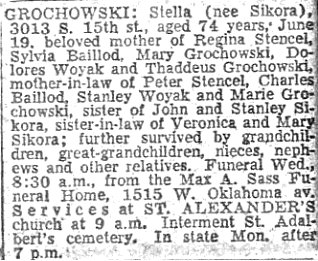
Obituary of Stella Sikora Grochowski – June 22, 1954 – Milwaukee
Sentinel
After the death of Michael Grochowski, Stella (Sikora) Grochowski lived with the family of her daughter Sylvia
along with her daughter Mary. Stella
died on June 19, 1954 from cancer
and is also buried at St. Adalbert’s in Section 10,
Block 2, Lot 17n2, Grave 3. (See
family tree appendix for complete descendent listing; see St. Adalbert’s Map for grave locations)
The Families Today
Our Grochowski
and Sikora descendent families are now generally in
their 6th generation since immigrating. Few if any family members are still living
who personally met or remember anyone from the 1st generation, and the 2nd
generation is rapidly passing into memory.
Most of the 3rd generation descendents are no longer with us
and the 4rth generation is rapidly graying.
It is consequently, important that we pause at this juncture to record
our history, while those who remember it are still with us.
Family members are now distributed
across the US,
although many remain in Wisconsin. Few of the 4th generation families have
regular contact with each other and most recall each other only from family
gatherings in the 1950s. Very few 5th
generation descendents have ever met one of their second cousins. This reunion is consequently, a good
opportunity to meet some of the people we’ve heard our parents and grandparents
reminiscing about. It is also a good
opportunity to share our remembrances, make new friends and to record family
information for our descendents.
Few of us beyond the 3rd
generation can still lay claim to being 100% Polish, but most of us still have
been exposed to significant aspects of the Polish Milwaukee culture. Many of us from the 4th and 5th
generations still prepare an occasional Polish dish and we still know the
meaning of a few Polish words. However,
for most of the family members born after 1980, our Polish roots will be known
primarily through anecdotal information.
If you get a chance, take the
time to see some of the old homes where our ancestors lived. Visit the old churches, neighborhoods and
cemeteries. Milwaukee’s
old Polish neighborhoods around Mitchell and Lincoln still retain a great deal
of their original immigrant character and are now the home to many new
immigrant families. I recall that when I
located many of the old homes of our ancestors, I was astounded at how small
they seemed for the 2 or 3 large families that sometimes lived together in them
during the 1890s. It was interesting to note
during my visits in the 1990s, that the homes were once again occupied by 2 or
3 large immigrant families and that despite the passage of over 100 years and
the changes in technology, the area still had a tangible, even palpable sense
of what life was like for our Polish ancestors.
Sikora Family
Descendents
The following linked database
includes all the descendents of the Sikora families
that I have located to date. The data
is far more complete for those branches of the family that have contacted
me and shared information.
In most cases, I have complete dates and places of birth, marriage
and death, but did not include them here in the interest of space.
A family tree with complete information is available online at http://wc.rootsweb.com/cgi-bin/igm.cgi?op=GET&db=2188007&id=I0495
but does not include first names or dates for living persons.










